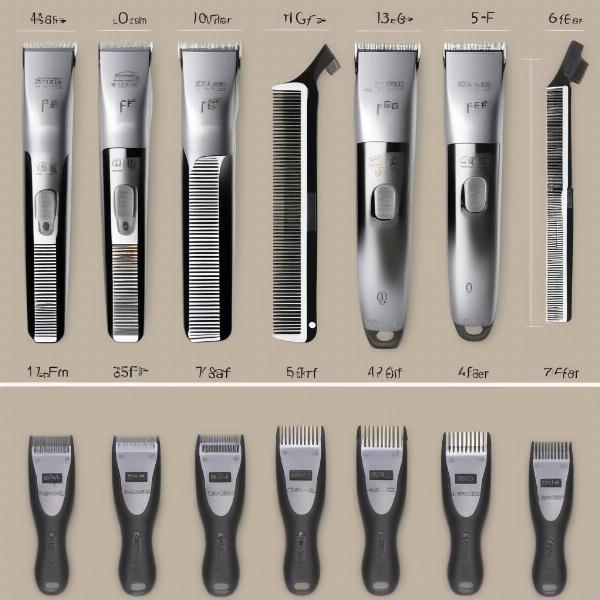Dog clipper blades are essential tools for grooming your furry friend, whether you’re a professional groomer or a pet owner who prefers DIY grooming. Choosing the right blade can make all the difference between a smooth, even cut and a choppy, uneven mess. Understanding the various types of blades, their uses, and how to maintain them will help you achieve professional-looking results and keep your dog comfortable throughout the grooming process.
Understanding Dog Clipper Blade Sizes and Their Uses
Choosing the right blade size is crucial for achieving the desired coat length and avoiding skin irritation. Dog clipper blades are numbered, and the lower the number, the shorter the cut. For example, a #7F blade leaves a longer coat than a #10 blade.
- #10 Blade: This blade is commonly used for trimming sensitive areas like the face, paws, and sanitary areas. It leaves a very short cut, almost like shaving.
- #7F Blade: A popular choice for a short, smooth cut on the body, often used for breeds like Poodles and Cocker Spaniels. It leaves a slightly longer coat than a #10.
- #5F Blade: This blade provides a medium-length cut, suitable for breeds that require a bit more length.
- #4F Blade: Ideal for longer cuts and blending, this blade is often used for creating a natural look.
 Dog Clipper Blade Sizes Chart
Dog Clipper Blade Sizes Chart
Choosing the Right Blade for Your Dog’s Breed and Coat Type
Different breeds and coat types require different clipper blades. Consider your dog’s individual needs when selecting a blade.
- Short-coated breeds: #7F or #10 blades are often suitable for breeds like Bulldogs, Boxers, and Beagles.
- Medium-coated breeds: #5F or #4F blades are a good choice for breeds like Golden Retrievers, Labradors, and Australian Shepherds.
- Long-coated breeds: Longer blades, like a #3F or even specialty blades, may be necessary for breeds like Shih Tzus, Yorkies, and Afghan Hounds.
Maintaining Your Dog Clipper Blades for Optimal Performance
Proper maintenance is essential for extending the life of your clipper blades and ensuring a smooth, comfortable grooming experience for your dog.
- Cleaning: Brush away excess hair after each use and regularly clean the blades with a blade wash or disinfectant.
- Oiling: Lubricate your blades with clipper oil to prevent friction and overheating.
- Sharpening: Dull blades can pull on the hair and cause discomfort. Sharpen your blades regularly or have them professionally sharpened.
What are the different types of dog clipper blades?
There are two main types of dog clipper blades: Ceramic blades and stainless steel blades. Ceramic blades stay cooler than stainless steel blades, which is beneficial for longer grooming sessions. wahl dog clipper blades are known for their quality and durability.
How do I choose the right blade for my dog’s sensitive skin?
For dogs with sensitive skin, it’s recommended to use a higher-numbered blade (like a #7F or #5F) to leave a longer coat and minimize the risk of irritation. dog hair clipper blades come in a variety of sizes to accommodate different coat types and sensitivities. You can also consider using a blade coolant to further reduce irritation.
How often should I replace my dog clipper blades?
The lifespan of a clipper blade depends on frequency of use and proper maintenance. However, even with proper care, blades will eventually dull and need replacing. If you notice the blade pulling on your dog’s hair or the cut is uneven, it’s time for a new one. Consider exploring dog blades for clippers to find the best replacement for your needs.
Conclusion
Choosing the right dog clipper blades and maintaining them properly are essential for a successful grooming experience. By understanding the different blade sizes and their uses, as well as how to care for your blades, you can ensure a comfortable and stylish trim for your furry companion. wahl clipper blades for dogs are a reputable brand known for their quality and performance.
FAQ
- What is the difference between a #10 and a #7F blade? A #10 blade leaves a shorter cut than a #7F blade.
- How often should I oil my clipper blades? Oil your blades after each use and more frequently during longer grooming sessions.
- Can I use human clipper blades on my dog? It’s generally recommended to use clipper blades specifically designed for dogs.
- How can I tell if my blade is dull? A dull blade will pull on the hair, resulting in an uneven cut and potential discomfort for your dog.
- What are skip tooth blades used for? Skip tooth blades are designed for thinning thick coats and removing mats.
- Where can I buy dog clipper blades? Dog clipper blades are available at pet supply stores, online retailers, and grooming supply stores.
- What is the best way to clean my clipper blades? Use a clipper blade wash or disinfectant and a small brush to remove hair and debris.
Related Articles:
About ILM Dog:
ILM Dog is your trusted international resource for comprehensive dog care and breed information. We offer expert advice on everything from choosing the right breed to health, training, nutrition, grooming, and much more. Whether you’re a seasoned dog owner or just starting your journey, ILM Dog provides practical and reliable information to help you give your canine companion the best possible care. For personalized advice or any inquiries, contact us at [email protected] or call us at +44 20-3965-8624.